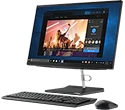What are smart speakers and smart displays?
A smart speaker is a wireless, voice activated device that uses integrated virtual assistant software to obtain information or perform tasks and provide the results aurally for the user to hear. A smart display does the same thing but presents its results visually on a screen in addition to through a speaker.
Smart speakers and smart displays are always "on" and listening for their virtual assistants' activation words (such as "Cortana" for Microsoft products, "Google" for Google ones, "Siri" for Apple, and "Alexa" for Amazon). The virtual assistant software is interactive (it can ask you to clarify a request, for example) and attempts to learn as it goes so each new request is more likely to be understood.
Smart speakers earned immediate popularity and widespread media coverage upon their debut in 2015. Within less than three years, multiple public surveys estimated that more than 10% of U.S. residents owned a smart speaker. And the number was expected to quickly grow to 20% or higher as new models -- including the Lenovo Smart Display, unveiled in 2018 -- would expand public interest in the innovative systems.
Origins of smart speakers and smart displays
Smart speakers and smart displays were once thought to be so futuristic that they appeared mostly in science fiction films. Imagine simply speaking aloud and having an unseen computer system turn your questions and commands into answers or actions.
By this measure, at least, the future arrived in early 2015, when the first mainstream smart speaker, the Amazon Echo, hit store shelves and home living rooms. Users were amazed that simply uttering "Hey Alexa" could help them search for recipes, adjust home lighting, send email messages, and more -- with the results instantly voiced to them.
But a picture is worth 1,000 words, or so it's said. So, if a smart speaker is handy, a smart display could be even more useful. Would you rather see a traffic map or hear about one? Is a recipe better when read line-by-line or when you can visually scan the whole thing?
The answers are obvious, and in 2018 the first consumer-focused smart display entered the marketplace: the Lenovo Smart Display. Designed like a furniture accessory with a large, bright screen, the Smart Display gained immediate public interest as the first device in its category powered by the highly popular Google Assistant software agent.
How do smart speakers and smart displays work?
In common public perception, smart speakers and smart devices are almost indistinguishable from the virtual assistants that power them. But the virtual assistants are also used in smartphones, PC operating systems and even some televisions. The "magic" in a smart display or smart speaker is that it frees users from those other devices and allows them to ask questions or give commands simply by speaking from anywhere in a room.
Once turned on and with minimal set-up (connecting to your home/office wireless signal, for instance), smart speakers and smart displays are usable almost instantly. And if the integrated virtual assistant is from a manufacturer whose products you already use -- email and messaging, video calling, cloud storage, etc. -- then the device will likely already be optimized to utilize these services easily. In fact, for many consumers, the product ecosystem to which a smart speaker or smart display belongs (Google, Apple, Microsoft, etc.) is a big factor in choosing which one to buy.
Smart displays and smart speakers are always "on" and listening for their activation word, and they try to remember what they've heard and done in the past to improve how they respond to future requests. This makes the devices both incredibly convenient and potentially troublesome, since the wrong combination of words could initiate an unintended command, or parts of everyday conversations might be stored -- innocently (to improve future performance) but possibly without users' knowledge. However, developers are constantly improving the devices' capabilities in speech recognition and natural language understanding, reducing errors significantly. The systems also can be adjusted to use different activation words or longer activation phrases. Further, manufacturers continue to refine the devices to ensure user privacy is protected while still enabling the devices to improve over time.





















